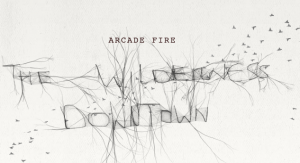Interactive Personalized Music Videos
 Few will argue that the music industry has been raped and pillaged by the proliferation of easily accessible first generation digital copies of their product. One of the last bastions they have is the concerts, merchandise and of course, music videos. However, since “Video Killed The Radio Star” echoed through the airwaves in 1981 on MTV, the format has remained largely unchanged, except for larger budgets and more credibility. MTV based their entire line up around the notion of music videos, but today has moved away from the medium that made it so popular.
Few will argue that the music industry has been raped and pillaged by the proliferation of easily accessible first generation digital copies of their product. One of the last bastions they have is the concerts, merchandise and of course, music videos. However, since “Video Killed The Radio Star” echoed through the airwaves in 1981 on MTV, the format has remained largely unchanged, except for larger budgets and more credibility. MTV based their entire line up around the notion of music videos, but today has moved away from the medium that made it so popular.
As an artist, it was a huge milestone to get yourself on MTV in your own music video. Depending on your viewpoint, it was the official sign you’ve made it, or sold out. The budget you’d need to make a music video was prohibitive, and then finding an audience was nearly impossible without the ubiquitous music television.
Thirty years later, almost everything that started the medium has changed. Suddenly, you needn’t have a huge budget in order to make a music video. “Prosumer” video cameras have opened up professional quality recording to average Joe’s. The ability to create something professional and then syndicate it to a huge audience has never been easier with the invention of modern compression codecs, high speed internet, and huge audiences at sites like YouTube, Vimeo and Facebook. The barrier to entry to share a fim accompaniment to your music has been almost eliminated. Unfortunately, this has lead to a flooding of the market. Almost 7 million videos are returned for “Music Video” on YouTube.
In this crowded market, it’s even more important to differentiate yourself. If you’re a relatively obscure artist, it’s critical. In fact, a great music video can launch your career to new heights. The UK’s “Ok Go” is perhaps the preeminent player in this regard. Their single shot music videos have gone viral time and time again, and even won them a Grammy award. Below is “Here It Goes Again”, their most noteable music video.
While the innovation in the music video space has been pushed by bands like OK Go, it still is at heart a music video. The desire to keep “film making” from meddling into the creativity is admirable, but it still puts them in the same category as everyone has been competing in for the last 30 years.
 In late August 2010, a new kind of music video started sweeping the web. It was an “interactive interpretation” of Arcade Fire – We Used To Wait created and directed by Chris Milk. It’s a riveting song by itself, but Milk uses a tie in with Google Maps in order to personalize the video. Instead of just watching something, you suddenly become part of the video. The algorithm powering it is still unclear as people have reported that it showed them their high schools, or places they used to hang out around town. However, the film is centered around you, and while lead singer Win Butler regales us with memories of a time when he “used to write letters, used to sign his name”, Milk’s interpretation is bringing us through parts of the street where each one of us grew up.
In late August 2010, a new kind of music video started sweeping the web. It was an “interactive interpretation” of Arcade Fire – We Used To Wait created and directed by Chris Milk. It’s a riveting song by itself, but Milk uses a tie in with Google Maps in order to personalize the video. Instead of just watching something, you suddenly become part of the video. The algorithm powering it is still unclear as people have reported that it showed them their high schools, or places they used to hang out around town. However, the film is centered around you, and while lead singer Win Butler regales us with memories of a time when he “used to write letters, used to sign his name”, Milk’s interpretation is bringing us through parts of the street where each one of us grew up.
Milk’s film quickly went viral, and was shared not only for it’s extremely original take, but because of the technology he used to create the effect. Interestingly, while millions of people shared his creation, nobody saw the same exact film. Perhaps the feelings it evoked were similarly nostalgic, but the level of customization involved means that millions of different films were created.
 Following on the success of The Wilderness Downtown, Brooklyn based trio Aurevoire Simone released not only a music video, but an interactive one as well. Their song “Knight Of Wands” has an eerie undertone of the macabre. Playing on this, their music video takes place in some kind of seance, but instead of just watching, you get to participate. A book is opened to a picture and you get to the decide how to color in the picture. As you color, various surprises happen to objects you color. I played at least three times so I could see all the cool things that were going to happen. The music video is available at The Knight Of Wands.
Following on the success of The Wilderness Downtown, Brooklyn based trio Aurevoire Simone released not only a music video, but an interactive one as well. Their song “Knight Of Wands” has an eerie undertone of the macabre. Playing on this, their music video takes place in some kind of seance, but instead of just watching, you get to participate. A book is opened to a picture and you get to the decide how to color in the picture. As you color, various surprises happen to objects you color. I played at least three times so I could see all the cool things that were going to happen. The music video is available at The Knight Of Wands.
The millennials have more technology at their disposal than ever before, and as the lines between jobs start to blur, you’re going to find more and more people shrug the notion of “a creative” and become technical to achieve their vision. The poor job market and readily available technology has left lots of room for people to make names for themselves.
The interactive music video in it’s current incantation is just the beginning. In the next year, I predict we’ll see geographic, and maybe even social based music videos. An iPhone application could track your progress through a night, and Google Street view could play it back for you, bringing up GPS based pictures you took. A simple API tie into Facebook means that a video could feature your pictures, and all of your friends.The profile pictures could be used as avatars to play out scenes. You could be the star, and all your friends the supporting cast. Let’s just hope the algorithm doesn’t put one of your parents as the leading romantic role.
